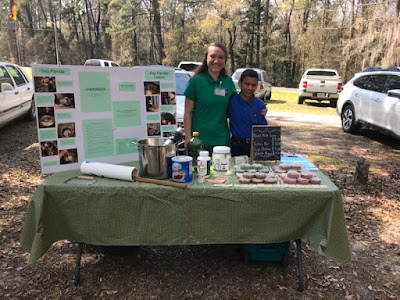History of Soapmaking
We provided an exhibit featuring an original soap recipe from the Salzburgers and a historical timeline of soapmaking:
Soap Recipe from De Olde Time Salzburger Cookbook, contributed by Mr. Alvin Gnann
One tin quart of water. One ball of sterling potash. Put water and potash in wash pot and dissolve. Add grease (if solid grease—add three pounds; if cracklings or meat scraps—add five pounds). Boil until it gets thick. Test a little in a saucer to see when it is firm. Pull fire away from pot and let set overnight. Cut into squares and set to dry.
History of Soapmaking -- A Timeline:
Old Testament – The Bible mentions cleansing agents (Jeremiah 2:22, Malachi 3:2).
2200 B.C. – Babylonians record formula for soapmaking consisting of water, alkali, and cassia oil.
1550 B.C. – Ebers papyrus, from Egypt, contains a recipe for a soap-like substance using animal and vegetable fats combined with alkaline salts.
77 A.D. – Pliny the Elder describes the manufacturing of soaps in his Historia Naturalis encyclopedia.
500s – Soapmakers in Naples, Italy form a guild.
1200s – Soapmaking becomes an industry in England.
1621 – American colonies start exporting potash (lye solution made by soaking ashes in water, then draining the liquid for use in soapmaking) to England.
1791 – Nicolas Leblanc produces a process for efficiently manufacturing caustic soda (lye) from salt.
1800s – Chemist M. E. Chevreul researches and documents the basic principles of saponification (the process of lye and fats/oils becoming soap).
1806 – William Colgate of New York founds a company specializing in soap manufacturing.
1850 – Soapmaking becomes the fastest-growing industry in America.
1877 – James Shuptrine (of Georgia Salzburger descent) opens a pharmaceutical company, Shuptrine Company, in Savannah where he markets soaps and salves for skin ailments.
1916 – During shortages of animal and vegetable fats and oils in both of the World Wars, chemists develop synthetic materials for cleaning, known as detergents.
Bibliography:
Ellis, Marietta and Arthur. “Colonial Soap Making—Its History and Techniques” (http://www.garyolds.com/files/ColonialSoapMaking--HistoryTechniques.pdf).
Harden, William. A History of Savannah and South Georgia, Volume II. Chicago and New York; The Lewis Publishing Company, 1913.
Makela, Casey. Milk-Based Soaps. North Adams, MA; Storey Publishing, 1997.
Mandal, Dattatreya. “The short history of soap – from ancient Mesopotamia to Proctor & Gamble” (https://www.realmofhistory.com/2016/08/10/origin-soap-ancient-mesopotamia-2800-bc/).
Soap History. “The History of Soap - When Soap Became Popular?” (http://www.soaphistory.net/soap-history/history-of-soap/).
Wikipedia. “Soap” (https://en.wikipedia.org/wiki/Soap).




Comments
Post a Comment